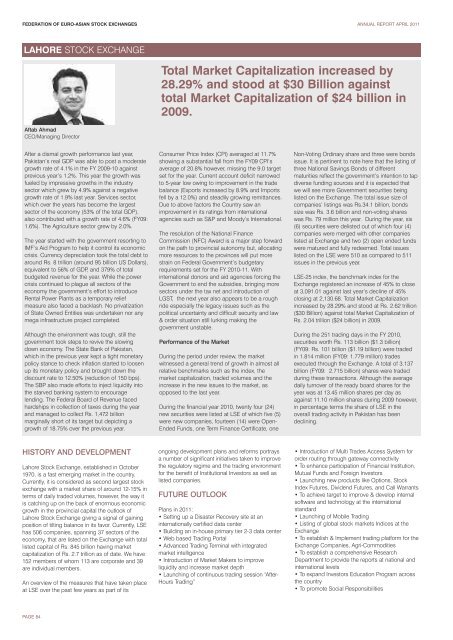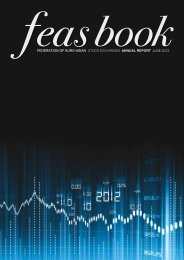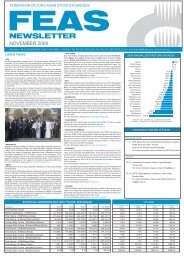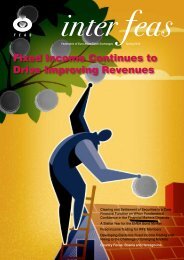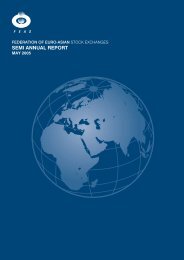Download - FEAS
Download - FEAS
Download - FEAS
You also want an ePaper? Increase the reach of your titles
YUMPU automatically turns print PDFs into web optimized ePapers that Google loves.
FEDERATION OF EURO-ASIAN STOCK EXCHANGES ANNUAL REPORT APRIL 2011<br />
LAHORE STOCK EXCHANGE<br />
Aftab Ahmad<br />
CEO/Managing Director<br />
Total Market Capitalization increased by<br />
28.29% and stood at $30 Billion against<br />
total Market Capitalization of $24 billion in<br />
2009.<br />
After a dismal growth performance last year,<br />
Pakistan’s real GDP was able to post a moderate<br />
growth rate of 4.1% in the FY 2009-10 against<br />
previous year’s 1.2%. This year the growth was<br />
fueled by impressive growths in the industry<br />
sector which grew by 4.9% against a negative<br />
growth rate of 1.9% last year. Services sector,<br />
which over the years has become the largest<br />
sector of the economy (53% of the total GDP),<br />
also contributed with a growth rate of 4.6% (FY09:<br />
1.6%). The Agriculture sector grew by 2.0%.<br />
The year started with the government resorting to<br />
IMF’s Aid Program to help it control its economic<br />
crisis. Currency depreciation took the total debt to<br />
around Rs. 8 trillion (around 95 billion US Dollars),<br />
equivalent to 56% of GDP, and 379% of total<br />
budgeted revenue for the year. While the power<br />
crisis continued to plague all sectors of the<br />
economy the government’s effort to introduce<br />
Rental Power Plants as a temporary relief<br />
measure also faced a backlash. No privatization<br />
of State Owned Entities was undertaken nor any<br />
mega infrastructure project completed.<br />
Although the environment was tough, still the<br />
government took steps to revive the slowing<br />
down economy. The State Bank of Pakistan,<br />
which in the previous year kept a tight monetary<br />
policy stance to check inflation started to loosen<br />
up its monetary policy and brought down the<br />
discount rate to 12.50% (reduction of 150 bps).<br />
The SBP also made efforts to inject liquidity into<br />
the starved banking system to encourage<br />
lending. The Federal Board of Revenue faced<br />
hardships in collection of taxes during the year<br />
and managed to collect Rs. 1,472 billion<br />
marginally short of its target but depicting a<br />
growth of 18.75% over the previous year.<br />
Consumer Price Index (CPI) averaged at 11.7%<br />
showing a substantial fall from the FY09 CPI’s<br />
average of 20.8% however, missing the 9.0 target<br />
set for the year. Current account deficit narrowed<br />
to 5-year low owing to improvement in the trade<br />
balance (Exports increased by 8.9% and Imports<br />
fell by a 12.0%) and steadily growing remittances.<br />
Due to above factors the Country saw an<br />
improvement in its ratings from international<br />
agencies such as S&P and Moody’s International.<br />
The resolution of the National Finance<br />
Commission (NFC) Award is a major step forward<br />
on the path to provincial autonomy but, allocating<br />
more resources to the provinces will put more<br />
strain on Federal Government’s budgetary<br />
requirements set for the FY 2010-11. With<br />
international donors and aid agencies forcing the<br />
Government to end the subsidies, bringing more<br />
sectors under the tax net and introduction of<br />
LGST, the next year also appears to be a rough<br />
ride especially the legacy issues such as the<br />
political uncertainty and difficult security and law<br />
& order situation still lurking making the<br />
government unstable.<br />
Performance of the Market<br />
During the period under review, the market<br />
witnessed a general trend of growth in almost all<br />
relative benchmarks such as the index, the<br />
market capitalization, traded volumes and the<br />
increase in the new issues to the market, as<br />
opposed to the last year.<br />
During the financial year 2010, twenty four (24)<br />
new securities were listed at LSE of which five (5)<br />
were new companies, fourteen (14) were Open-<br />
Ended Funds, one Term Finance Certificate, one<br />
Non-Voting Ordinary share and three were bonds<br />
issue. It is pertinent to note here that the listing of<br />
three National Savings Bonds of different<br />
maturities reflect the government’s intention to tap<br />
diverse funding sources and it is expected that<br />
we will see more Government securities being<br />
listed on the Exchange. The total issue size of<br />
companies’ listings was Rs.34.1 billion, bonds<br />
size was Rs. 3.6 billion and non-voting shares<br />
was Rs. 79 million this year. During the year, six<br />
(6) securities were delisted out of which four (4)<br />
companies were merged with other companies<br />
listed at Exchange and two (2) open ended funds<br />
were matured and fully redeemed. Total issues<br />
listed on the LSE were 510 as compared to 511<br />
issues in the previous year.<br />
LSE-25 index, the benchmark index for the<br />
Exchange registered an increase of 45% to close<br />
at 3,091.01 against last year’s decline of 45%<br />
closing at 2,130.68. Total Market Capitalization<br />
increased by 28.29% and stood at Rs. 2.62 trillion<br />
($30 Billion) against total Market Capitalization of<br />
Rs. 2.04 trillion ($24 billion) in 2009.<br />
During the 251 trading days in the FY 2010,<br />
securities worth Rs. 113 billion ($1.3 billion)<br />
(FY09: Rs. 101 billion ($1.19 billion) were traded<br />
in 1.814 million (FY09: 1.779 million) trades<br />
executed through the Exchange. A total of 3.137<br />
billion (FY09: 2.715 billion) shares were traded<br />
during these transactions. Although the average<br />
daily turnover of the ready board shares for the<br />
year was at 13.45 million shares per day as<br />
against 11.10 million shares during 2009 however,<br />
in percentage terms the share of LSE in the<br />
overall trading activity in Pakistan has been<br />
declining.<br />
HISTORY AND DEVELOPMENT<br />
Lahore Stock Exchange, established in October<br />
1970, is a fast emerging market in the country.<br />
Currently, it is considered as second largest stock<br />
exchange with a market share of around 12-15% in<br />
terms of daily traded volumes, however, the way it<br />
is catching up on the back of enormous economic<br />
growth in the provincial capital the outlook of<br />
Lahore Stock Exchange giving a signal of gaining<br />
position of tilting balance in its favor. Currently, LSE<br />
has 506 companies, spanning 37 sectors of the<br />
economy, that are listed on the Exchange with total<br />
listed capital of Rs. 845 billion having market<br />
capitalization of Rs. 2.7 trillion as of date. We have<br />
152 members of whom 113 are corporate and 39<br />
are individual members.<br />
An overview of the measures that have taken place<br />
at LSE over the past few years as part of its<br />
ongoing development plans and reforms portrays<br />
a number of significant initiatives taken to improve<br />
the regulatory regime and the trading environment<br />
for the benefit of Institutional Investors as well as<br />
listed companies.<br />
FUTURE OUTLOOK<br />
Plans in 2011:<br />
• Setting up a Disaster Recovery site at an<br />
internationally certified data center<br />
• Building an in-house primary tier 2-3 data center<br />
• Web based Trading Portal<br />
• Advanced Trading Terminal with integrated<br />
market intelligence<br />
• Introduction of Market Makers to improve<br />
liquidity and increase market depth<br />
• Launching of continuous trading session “After-<br />
Hours Trading”<br />
• Introduction of Multi Trades Access System for<br />
order routing through gateway connectivity<br />
• To enhance participation of Financial Institution,<br />
Mutual Funds and Foreign Investors<br />
• Launching new products like Options, Stock<br />
Index Futures, Dividend Futures, and Call Warrants<br />
• To achieve target to improve & develop internal<br />
software and technology at the international<br />
standard<br />
• Launching of Mobile Trading<br />
• Listing of global stock markets Indices at the<br />
Exchange<br />
• To establish & Implement trading platform for the<br />
Exchange Companies, Agri-Commodities<br />
• To establish a comprehensive Research<br />
Department to provide the reports at national and<br />
international levels<br />
• To expand Investors Education Program across<br />
the country<br />
• To promote Social Responsibilities<br />
PAGE 84


